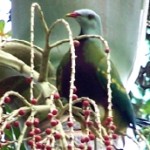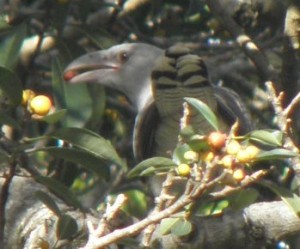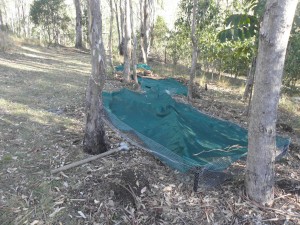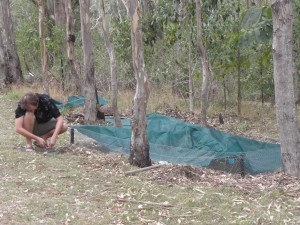This is a reproduction of what will shortly appear on the Scenic Rim Wildlife website
(Scenic Rim Wildlife is the Scenic Rim Branch of the Wildlife Preservation Society of Queensland)
Wildlife Corridors Workshop
April 2011, Heritage Centre, Tamborine Mountain
The workshop was well attended by a wide range of people from within the Scenic Rim and other regions, and it is hoped the momentum will continue into future action.
The following is from notes taken by the chair, with apologies to presenters if anything important was missed
Introduction – Ronda Green
(Chair Scenic Rim Wildlife)
Ronda spoke briefly on reasons animals need to move (daily, seasonally, after disasters, finding mates and territories etc.), the value of corridors also in allowing genetic exchange and avenues for recolonization after natural or human-indiced disasters, and the barriers to movements created by increasing human populations. Provision of corridors is not a ‘one-size-fits-all’: we need to understand what is needed by different kinds of wildlife. She stressed the need for information gathering if we are to solve present and future problems – information on where animals are and what they need, and also information on future plans by local, state and federal government and developers so that ecological decisions are not left until the final stages of major plans.
Corridors and roads international and local – Cathryn Dexter
 (SEQ Koala Retrofit & Road Mitigation Project Manager, Applied Road Ecology Group, Environmental Futures Centre and , Griffith School of Environment, Griffith University)
(SEQ Koala Retrofit & Road Mitigation Project Manager, Applied Road Ecology Group, Environmental Futures Centre and , Griffith School of Environment, Griffith University)
Catherine showed maps of corridors and reserves and pointed out that the decisions on placement of reserves are not always based on what is best for conservation value but frequently for recreational or political reasons. Effective planning for wildlife movement needs local, state and national scales.
In a fragmented landscape, the greater the number of fragments, and the closer they are, the more likely dispersal of wildlife will occur between them.
Factors influencing use of corridors:
- Biology and ecological requirements of particular species
- Habitat suitability
- Location of corridors
- Land use
- Suitability of habitat in areas surrounding strips
- The values of the reserves being connected (the large habitat areas that the corridors lead to)
- They need to be designed for animals that are vulnerable to extinction: it is not enough for just the most common species to be using them.
Some consideration of roads, which cut across many animal pathways nowadays and will do so even more in the future –
- there is a footprint surrounding a road – whether the edges are cleared, lights, noise etc. beyond the area taken up by the road itself
- mortality of animals crossing roads – very high in some areas
- roadside habitat enhancement can draw in animals, for instance mown grass at the edges that will entice wallabies to feed by the roadside, and roadkill produces more roadkill if eagles, quolls and other carrion feeders are attracted
- public safety – collisions with larger animals can be serious
Strictly migratory animals – as are more common in other continents – are easier to cater for than more random movements, because a bridge or tunnel accommodating their usual route will often be used very quickly by the regular migrants. Our more random and nomadic wildlife are not quite so easy
European approach
European Union directives
1979 Birds, 1992Habitats Directive led to Natura 2000 network of sites, with a formal agreement to abide by the directives or face the EU court
Europe has many more faunal overpasses than Australia does.
If European countries – with all their political differences – can work together in this way Australian states united by federation and a common culture should be able to similar.
On one road in Spain there are several overpasses of 86-475m – 6 viaducts, 5 tunnels. Total permeability of this road: 47.5%
Compton Road, Brisbane
Glider populations were to be separated by the new road
Land bridges and fauna tunnels, fences, rope ladders for arboreal mammals and glider poles were all planned and ultimately implemented
The overpass has been a great success, and is being used by many kinds of animals – marcopds, gliders, snakes, small bush birds and others.
SEQ Koala Retrofit & Roadkill Mitigation Project
There has been an alarming decline in koalas, mostly due to cars, dog attacks and disease
12745 deaths between 1997 and 2009
Hotspots have been identified
Many koalas are now radio tracked to follow and understand movements – different individual koalas differ in their kinds of movement, challenging some of our our assumptions about corridor placement and habitat suitability.
Some roads are administered by council, some by state – sometimes different policies interfere with overall effectiveness
Green Infrastructure – Jaap Vogel
(Local artist and naturalists, former Tamborine Mountain LandCare president)
Green Infrastructure – a sustainable network of nature, parks and agricultural land, connecting corridors
April 2007 – groups got together to send a message to council about Whole Of Shire Planning
Green infrastructure needs the same kind of process as designing built infrastructure. It supports native wildlife, water management and other ecological phenomena, and involves whole community
The infrastructure consists of hubs, links and sites
We need to establish modelling parameters: what do we want to achieve – identifying ecological features, then the hubs and linkages, identifying cultural/historical features, selecting trailheads and identifying corridors
AGIC (Australian Green Infrastructure Council) – the principle industry catalyst for advancing sustainability – does not mean quite the same as we do when speaking of green infrastructure
Example of green infrastructure in USA:
Florida – 700,000 acres, 2,300km of trails, bought 1.7m acres for $3b over 10 years, funding was from government and private sources
They provide linkages for wildlife, protection of drinking water, guards against flooding, purifying of air, and enhancement of tourism
What we can do about green infrastructure locally
The first step towards a goal of this kind is mapping – this has already been accomplished on Tamborine Mountain
The former Beaudesert Shire mapped wildlife corridors around some of the the boundaries of the shire, not much else
The Border Ranges map of corridors shows a corridor from Tamborine Mountain to the NSW border, but cut by roads, e.g. at Canungra (and some cleared areas)
There is now a Tamborine Mountain map showing hubs and corridors
The corridor from Thunderbird Park through to Cedar Creek Winery and beyond is a good example of what can be done. It involves multiple land tenures, 5 private landholders, and 65% is already consolidated with the help of volunteers and landowners.
The Tamborine Creek catchment is another corridor examples, including Botanic Garden, McDonald section of Tamborine NP, Contour Rd., old sawmill, Joalah etc. There is a problem of a road just east of the old sawmill with a high priority to creatae a crossing.
GI is however more than just corridors for wildlife, and it involves the ability for many groups of people to work together to accomplish them. It is suggested that we form such a coalition of groups for this purpose locally.
Michael Anderson – Wildlife corridors in the Scenic Rim
(Environmental Team Leader, Scenic Rim Regional Council)
The Scenic Rim includes 8 endangered ecosystems (ecosystems with <10% former area remaining in Qld), 22 ‘of concern’ (10-30% remaining), 25 least concern (>30% remaining). Despite some large areas of national parks and other reserves, most of this is still on private land. “Least concern” is an unfortunate title, leading to the attitude that it is okay to clear plenty of it.
Corridors can be stepping stones, riparian strips, ridgelines etc.
As vegetation patches reduce in size, they are less viable ecologically,
A draft map was shown as a tool for deciding priorities for reducing clearing, habitat restoration and for such decisions as where to utilize Vegetation offsets (Energex etc.)
- An eastern corridor – with some breaks – leads from Lamington to Tamborine Mountain
- A central one – again with breaks – leads from Mt Barney through Kooralbyn northwards – heads to Oxley but then what?
- A western one runs up the main range
We lack good west-to-east corridors through the main part of the region, and there are many other gaps
Some important gaps are those around Beaudesert, Kooralbyn, Mt Chinghee, Kerry, Bremer & Warrill View area, Rathdowney-Maroon, Boonah-Beaudesert, Mt Lindsay Highway, Cunningham Highway.
Corridior problems include:
- loss of habitat
- individual habitat tree removal (e.g. old trees with hollows, big feed-trees)
- inappropriate fire regimes
- climate change
- predation
- weeds
- barriers – fences, roads etc
- state infrastructure – dams, interstate rail, motorbike parks
- nonregional offset policies – may offset something by purchasing land elsewyere, not heling local area
- limited vegetation protection
Management:
- Maintain and increase vegetation
- Provide specific habitat resources for various animal groups
- Maximize width and function, protection, minimize barriers
Regional programs
- SEQ fire & biodiversity consortium
- SEQ biodiversity offsets
- Health waterways
- Glossy Black Cockatoo Conservancy
- Regional green Energy project
- Main roads weed treatment
- Carbon sink project
- NRM plan – tartgets tp achieve as local government and regional community (big step forward but not yet statutory)
- Land for Wildlife
- Macadamia Recovery Project
Concil programs
- River improvement
- Environmental grants
- Property conservation
- Environmental planning support
- Reserve management
- Climate change management
- Environmental events
- Publications
- Community groups
- Rivers management (bank rehabilitation, fencing off cattle access)
- Pest management
- Education (schools and other)
Fututre programss
- Expand current base programs
- Extenal funding
- Communal Nursery
- Environmental education centre
- Expanded community gardens
- Consolidated offset program
- Small block wildlife program
- Expand wildlife corridors projects
- Koala fodder trees
- Flora and fauna database
- Greater arts lnkage
- Biosphere
- Ecosystem services
- Wildlife ambulance
Geoff Warne – wildlife corridor through Cedar Creek wineries
(Guide, Cedar Creek Estates Winery and Glow Worms)
11 years ago the property mostly had old rhubarb and avocado area, not in good condition. John Pengliss, the managing director of Cedar Creek Estate decided to plant native rainforest trees along Cedar Creek, and this was to become part of a corridor involving other landowners and linking conservation areas (as mentioned in Jaap’s talk previously). The trees and other plants have grown remarkably well since then, providing a closed canopy and general rainforest feeling underneath, and are a good example of what can be accomplished.
Bobucks and platypus were not originally seen on the property but have now moved in. Unfortunately snake-catchers have released too many carpet pythons on the property for the bobuck population to survive.
John Pengliss has put a permanent covenant on the land to prevent any future clearing
He also offered to build and artificial cave to house glow worms, as the local species were being threatened by the behaviour of many human visitors to their native haunts. This has also proved very successful. Frog hollow is another initiative soon to open to the public, sowing the frogs native to the Mountain
Lauren Barnaby – Wyaralong Dam and wildlife
(General Manager – Environment, Land and Cultural Heritage, Queensland Water Infrastructure Pty Ltd )
At capacity the dam will hold 103,000ML (10% Wivenhoe) covering 1,230ha
An extensive Environmental Impact Assessment was conducted in 2007, involving 1400 state approval decisions, also commonwealth conditions
75% of the land to be inundated was already cleared
11km of Beaudesert/Boonah Rd was realigned, and this needed faunal underpasses
There are 480 ha of wildlife corridor, including major wildlife N-S movement areas to the extreme Eastern and Western ends of the dam, and they are managing existing regeneration by exclusion of grazing, weed removal, and also planting of locally native trees. The Green Army was involved, collecting for an on-site nursery (30,000 seeds collected from existing habitat before clearing)
21 underpasses, 3 for fauna alone, were designed in accordance with the engineering design of the road to meet road standards: topography favoured under- rather than over- passes (high enough for grey kangaroo to move through)
They worked with EPA, looking at height, lighting etc. for different spp, whether dry ledges were required, vegetation at entrance and exits. Post and rails have been constructed for arboreal animals, with some escape posts leading upwards in case of approach by feral dogs etc.
The fauna fencing is now finished. 400 nest boxes of different sizes from Hollow Log Homes have been erected.
There will be 10 years of montoring and maintenance plan and corrective actions for environmental corridors, and
25 years of monitoring and maintenance of fauna underpasses – fauna usage, fatality, types & abundance of fauna
Summary of re-establishing biodiversity –
- 2 environmentt corridors
- 220ha revegetation
- 21 fauna underpasses
- 400 nest boxes
- land mngmt initiatives (e.g. cattle exclusion)
Persons interested in commenting on and asking questions on any of the above, volunteering for fauna surveys or telliing us where they have seen various species, , please contact scenicrim@wildlife.org.au or contribute to our Facebook page http://www.facebook.com/Scenic.Rim.Wildlife













